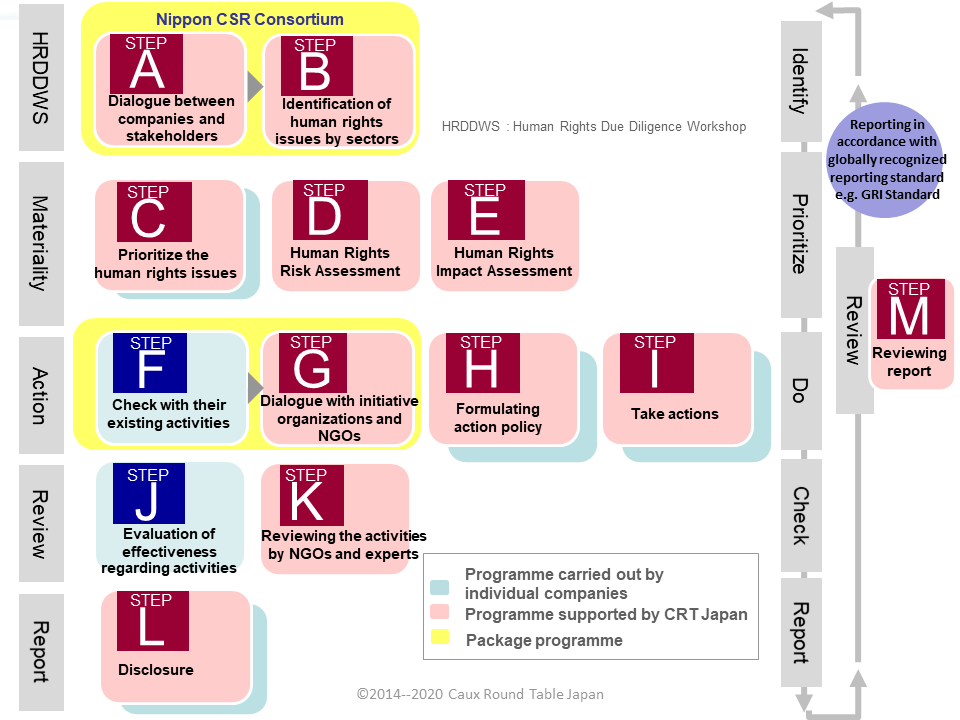CRT-Japan focuses on implementing of UN Guiding Principles on Business and Human Rights (hereafter, UNGPs) in to the companies, has constructed a comprehensive effort support program (Sustainable Navigation) in partnership with global initiative organizations. The feature of our approach is to “enable effective and efficient practice in the companies”. In addition to providing support for identifying prominent issues such as human rights risk assessment an impact assessment, providing a collaborative platform for stakeholder engagement and providing tools that can address the identified issues. We also support the implementation of human rights due diligence in companies required by UNGPs.
Steps of Sustainable Navigation

STEP A: Dialogue between companies and stakeholders
・ Understand stakeholders (especially those who are or may be exposed to human rights abuses)’ what are their concerns, expectations, and issues through dialogue with them.
・ Deepen understanding the background of human rights issues, the relationship between business activities and human rights, and important human rights issues, and importance of consideration about human rights on business activities, through dialogue among companies, NPOs/NGOs and experts on this field in Human Rights Due Diligence Workshop organized by CRT-Japan (STEP A and B on the table)
STEP B: Identification of human rights issues by sectors
・Understand the prominent human rights issues of your industry through dialogue with other companies in the same industry and with stakeholders, as industry characteristics can greatly affect the likelihood of human rights issues.
・Human Rights Due Diligence Workshop organized by CRT-Japan (STEP A and B on the table) divides companies into industry-specific groups, and each group organizes human rights issues that is particularly relevant and potentially prominent to the industry throughout the value chain. (Some NGOs/NPOs and experts participate)
STEP C: Prioritize the Human Rights issues
・Prioritize the Human Rights issues with the company’s business based on the important human rights issues for each industry that were organized in STEP B, and also assemble various materials from NGO reports.
STEP D: Human Rights Risk Assessment
・Evaluate human rights risks associated with business (Human Rights Risk
Assessment).
・In CRT-Japan’s Human Rights Risk Assessment, after conducting a human rights risk assessment based on objective data by JPR&C, extracts the human rights themes that the company should prioritize based on the results of hearing from related departments.
STEP E: Human Rights Impact Assessment
・Identify “who and what human rights are negatively affected / not affected” through local interviews and inspections targeting specific issues and countries.
・CRT Japan’s Human Rights Impact Assessment evaluates “who and what kind of human rights are negatively affected / not affected” from the three perspectives of “scale”, “range”, and “difficulty of correction”, through interviewing stakeholders and site visiting, and identify human rights issues.
CASE STUDY
ANA HOLDINGS INC.
Human_Rights_Report_2020.pdf
Nippon Yusen Kabushiki Kaisha (NYK Line)
https://www.nyk.com/english/esg/social/activities/
NISSIN FOODS HOLDINGS CO., LTD.
https://www.nissin.com/en_jp/sustainability/social/human-rights/
STEP F: Check with their existing activities
・Take an inventory of the current status of activities and sort out the issues involved in the activities (what is done and what is not done) for the outstanding issues identified through the above process.
・After sorting out the issues is completed, it is desirable to exchange opinions with experts in the field of human rights (initiative groups, NGOs, etc.) on the effectiveness of existing activities and what kind of activities are desired (STEP G).
STEP G: Dialogue with initiative organizations, NGOs/NPOs, stakeholders
・Exchange opinions with experts (initiative groups, NGOs, etc.) on how to deal with the issues identified in STEP F.
・Confirm that the priority issues to be addressed are appropriate and that there are no omissions.
・CRT Japan provides an opportunity for dialogue with overseas experts.
STEP H: Formulating action policy
・Develop an action plan to properly address the identified outstanding human rights issues.
・In dealing with human rights issues, considering collaboration with other organizations and utilization of various platforms is desirable.
・It is also desirable to consider incorporating it into business strategies and operations toward the integration of “business and human rights” into management decision making.
・CRT Japan supports formulating effective action policies with a view to integrate them into management, taking into account the circumstances of each company.
STEP I: Take actions
・Implement activities based on the activity plan.
・In addition to internal departments, some activities require engagement with suppliers, business partners, and related organizations.
・CRT Japan provides supply chain management tools and supports the implementation of individual programs, depending on the circumstances of client companies.
STEP J: Evaluation of effectiveness regarding activities
・Evaluate the effectiveness of activities to address human rights issues based on the activity plan.
・Organize what you are doing and what you are not doing at the moment, and what you have learned through your activities.
・After the arrangement work, it is desirable to exchange opinions with experts in the human rights field (initiative groups, NGOs, etc.) regarding the validity of effectiveness assessment and more effective approaches (STEP K).
STEP K: Reviewing activities by initiative organizations and experts
・Exchange opinions with experts (initiative groups, NGOs, etc.) regarding the effectiveness evaluation conducted at STEP J and the more effective approach.
・CRT Japan provides an opportunity for dialogue with overseas experts and companies.
STEP L: Disclosure
・Report progress and results of a series of initiatives externally.
・CRT Japan supports the preparation of reports in line with international reporting frameworks such as the UN Guiding Principles Reporting Framework.
STEP M: Reviewing report
・Review the contents and disclosure status after issuing the report.
・CRT Japan reviews reports in line with international reporting frameworks such as the UN Guiding Principles Reporting Framework.



